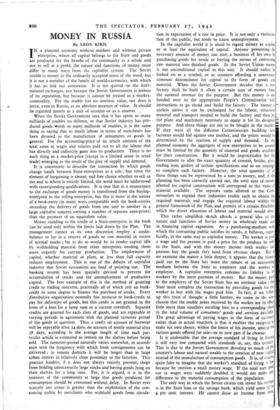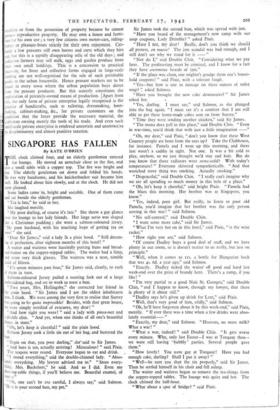MONEY IN RUSSIA
By LEON KIRIL IN a planned economy without markets and without private enterprise, where all capital belongs to the State and goods are produced for the benefit of the community as a whole and
• not to sell at a profit, the nature and functions of money must differ in many ways from the capitalist system. The Soviet rouble is money in the ordinarily accepted sense of the word, but it is not 'a member of the family of world-currencies, with which it has no link nor connexion. It is not .quoted on the inter- national exchanges, not because the Soviet Government is jealous of its reputation, but because it cannot be treated as a market- commodity. For the rouble has no intrinsic value, nor does it serve, even in Russia, as an absolute measure of value. It should be regarded merely as a unit of account or as a counter. ,
When the Soviet Government says that it has spent so many milliards of roubles on defence, or that Soviet industry has pro- duced goods Worth so many milliards of roubles, it is the same thing as saying that so much labour in terms of man-hours has been devoted to the manufacture of armaments or goods in general. For the accounting-price of an article consists of the total sums in wages and salaries paid out to all the labour that has directly and indirectly gone into its production. There is no such thing as a market-price (except in a limited sense in retail trade) emerging as the result of the play of supply and demand.,
It is convenient to describe the transaction by which goods change hands between State-enterprises as a sale ; but since the element of bargaining is absent, and free choice whether to sell or not and to whom is strictly limited, the word must be understood with corresponding qualifications. It is true that as a counterpart to the exchange of goods money is transferred from the buying- enterprise to the selling-enterprise, but this is more in the nature of a book-entry (in many ways comparable with the book-entries recording the delivery of goods from one unit to another in a large capitalist concern owning a number of separate enterprises) than the payment of an equivalent value.
Money standing • to the credit of a State-enterprise in the bank can be used only within the limits laid down by the Plan. The management cannot at its own discretion employ a credit- balance to lay in a reserve of goods or raw material in excess of normal stocks ; for to do so would be to render capital idle by withholding material from other enterprises needing them more urgently for current production. The employment of capital, whether material or plant, at less than full capacity reduces employment. This is one of the defects of capitalist industry that Soviet economists are fond of pointing out. The banking system has been specially devised to prevent the accumulation of stocks and the unemployment of productive capital. The best example of this is the method of granting credit to trading concerns, practically all of which rely on bank- credit to some degree to finance the purchase of stocks. Every distributive organisation normally has recourse to bank-credit to pay for deliveries of goods, but this credit is not granted in the form of a loan for a lump sum or a current overdraft. Separate credits are granted for each class of goods, and are repayable at varying periods in agreement with the planned turnover period of the goods in question. Thus a credit on account of footweat will be repayable after 24 days, on account of textile material after 38 days, according to the average length of time each par- ticular article is estimated to remain on the shelves before being sold. The turnover-period naturally varies somewhat, in accord- ance with the frequency with which fresh consignments can be delivered ; in remote districts it will be longer than in large urban centres in relatively close proximity to the factories. This practice hinders, if it does not always entirely prevent, shops from holding unnecessarily large stocks and having goods lying on their shelves for a long time. For, it is, argued, it is in the interests of the community 'at large that goods produced for consumption should be consumed without delay, In Soviet .eyes scarcely any crime is greater than the exploitation of the Con- suming public by merchants who withhold goods hem circula-
tion in expectation of a rise in price: It is not only a victim sa. tion of the public, but tends to cause unemployment. In the capitalist world it is usual to regard money as capital, or at least the equivalent of capital. Anyone possessing the necessary amount. of money can start a business Of his own by purchasing goods for resale or buying the means of converting raw material into finished goods. In the Soviet Union money
is not unconditional capital in this way. It should rather be
• looked on as a symbol, or as counters affording a convenient
common denominator for capital in the form of goods and material. When the Soviet Government decides that a new factory shall be built it allots a certain sum of money from the national revenue for the purpose. But this money is na handed over to the appropriate People's Commissariat with instructions to go ahead and build the factory. The money useless unless it can be exchanged for the -labour, structural material and transport needed to build the factory and then for the plant and machinery necessary to equip it for its designed purpose. And these things are not to be bought in the market If they were all the different Commissariats building new factories would bid against ohe another, and the-prices would be determined by the reaction of supply and demand. In the planned economy the aggregate of new enterprises to be created must be limited by the quantity of material and goods available for their construction. But it would be impracticable for the Government to allot the exact quantity of -cement, bricks, glass, roofing iron, girders of certain specifications and so on requirgd to complete each factory. However, the total quantity of all these things can be represented by a sum in money, and, if the planning has been correctly carried out, the total sum of money allotted for capital construction will correspond to the value of material available. The separate sums allotted to the Com- missariats to expand their industries enable each to obtain the required materials and engage the required labour within the general framework of the Plan, and permits of a certain flexibility which the direct allocation of labour and material would deny.
This rather simplified sketch affords a general idea of the nature and functions of Soviet money in wholesale 'trade and in financing capital expansion. As a purchasing-medium with which the consuming public, satisfies its needs, it behaves, super- ficially, in the same way as capitalist money. The worker is paid a wage and the peasant is paid a price for the produce he sells to the State, and with this money, income both worker and peasant buy the goods they need from obvious shops. But if we examine the matter a little deeper, it appears that the moneY paid out by the State has more the nature of .an accounting medium between the State as employer and the worker 25 employee. A capitalist enterprise redeems its liability to ne workers by the mere payment of money. But the money paid to the employee of the Soviet State has no intrinsic value ; the State must complete the transaction by providing goods for the worker to buy with the wages paid him. In fict, if we folio' up this train of thought a little further, we come to the or' clusion that the rouble notes received by the worker are in effect little more than vouchers entitling him to a corresponding shag in the total volume of consumers' goods and' services, available. Thegreat advantage of paying wages in the form of current"! rather than in actual vouchers is that it enables the recipient 10 make his own choice, within the limits of his income, among tile various goods offered for sale—or to save part if he chooses. .
It is undeniable that the average standard of living in Russ° is still very low compared with standards in, say, this 'counts!. This is due to the Soviet Government devoting so much of eht country's labour and natural wealth to the creation of new carpi instead of the manufacture of consumption goods. It is, of course, quite false to imagine that the worker's standard of living iS 10.1 because he receives a small money ..wage. If the total sum Po out in wages were suddenly doubled it would not Make ani difference to the material consumption of the pOpulation. The only way in which the Soviet citizen can invest his savIngl is in the State loan or the savings bank, which yield some 3310 4 Per cent. interest. He cannot draw an income from 104 royalties or from the possession of property because he cannot possess reproductive property. He may own a house and furni- ture for his own use ; a very few citizens own motor-cars, riding- horses or pleasure-boats strictly for their own enjoyment. Cer- tainly a few peasants still own horses and carts which they hire out, but this is a kapidly disappearing relic of the old days ; and collective farmers may sell milk, • eggs and garden produce from their own small holdings. This is 'a concession to practical necessity, for State and collective farms engaged in large-scale farming are not well-organised for the sale of such perishable goods to the urban housewife. Hence peasant markets are to be found in every town where the urban population buys direct from the peasant producer. But this scarcely constitutes the exploitation of privately-owned meani of production. 'Apart from !his, the only form of private enterprise legally recognised is the practice of handicrafts, such as tailoring, dressmaking, boot- making, cabinet-making, &c., for private customers on the condition that the latter provide the necessary material, the craftsman owning merely the tools of his trade. And even such small-scale private enterprise is rendered uncertain and unattract:ve be discriminatory and almost punitive taxation.































 Previous page
Previous page